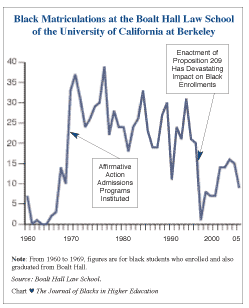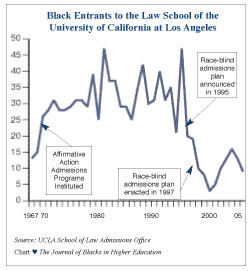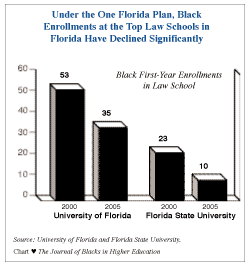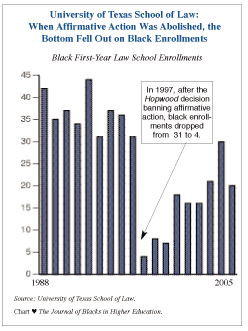| How State Bans on Race-Sensitive Admissions Have Damaged Black Enrollments in Professional Schools Despite the favorable ruling by the Supreme Court in the Grutter case reaffirming universities' consideration of race in admissions decisions, state bans on race-sensitive admissions continue to have a devastating effect on black opportunities for professional education.The 2003 Supreme Court ruling in Grutter v. Bollinger reaffirmed the practice of using race as a positive factor in the admissions process at the University of Michigan School of Law. Therefore, under federal law, state-operated law schools, as well as business, medical, and other professional schools, were permitted to consider race in their admissions decisions. However, all this meant was that there was no federal prohibition. States were still permitted to ban the practice if they so chose. Prior to the Grutter ruling, the consideration of race in state-operated professional school admissions was not permitted in the following five states: Florida, Georgia, Texas, Washington, and California. In Georgia and Texas, the ban on race-sensitive admissions had been the result of decisions by U.S. appeals courts. Those decisions in Georgia and Texas were overturned by the Grutter ruling. Therefore, professional schools in these states became free to reinstate race-sensitive admissions if they chose to do so. Some did, and some did not. But in Florida, California, and Washington, bans on race-sensitive admissions remain in effect despite the Grutter ruling. Public referendums that passed in California and Washington in the late 1990s outlawed the use of race in admissions decisions at undergraduate and graduate programs at state universities. In Florida, race-sensitive admissions were and continue to be outlawed under an executive order issued by Governor Jeb Bush.
Over the past several years, the sharp drop in black undergraduate enrollments at the elite campuses of the University of California and the University of Florida due to bans on race-sensitive admissions have been thoroughly documented by JBHE. At predominantly white state universities in Washington, Texas, and Georgia, black enrollments dropped immediately after the bans went into effect. But since that time black enrollments have recovered or surpassed earlier levels. On the following pages, JBHE reports on the trend in black enrollments at professional schools in these five states. In states in which affirmative action still is not permitted, black enrollments, particularly in law schools, remain well below the level that existed prior to the enactment of the bans on race-sensitive admissions. At some professional schools in Texas and Georgia, where race-sensitive admissions are now once again practiced, black enrollments have seen significant increases. Here is a summary of the trends in each of the five states where affirmative action admissions for professional schools were, or still are, in effect. In California, admissions officers at state-operated professional schools have not been permitted to use race as a factor in their decisions for nearly a decade. The impact of this ban, enacted by public referendum, has continued to have a devastating effect on black educational opportunities. At no school of higher education was the impact of the ban on race-sensitive admissions felt more severely than at the Boalt Hall law school of the University of California at Berkeley. In the mid-1970s, a strong affirmative action admissions program boosted black first-year enrollments to a high of 39 students. As late as 1994, 31 black first-year law students enrolled at Boalt Hall. The next year the regents enacted the affirmative action ban. Although the ban did not go into effect until 1997, the regents' plan put a damper on black law school enrollments. In 1996, the last year of race-sensitive admissions at the Boalt Hall law school, 20 first-year black students enrolled. In 1997 the regents' ban on affirmative action kicked in for graduate programs of the University of California. That year, black admits dropped from 77 to 18, a decrease of 76.6 percent. Black first-year enrollments dropped from 20 in 1996 to one in 1997. Since that time black first-year enrollments rebounded to a high of 16 in 2003. But at this level, black first-year law school enrollments are only about one half the level that prevailed in 1994. This past fall there were only nine black first-year students at Boalt Hall, a decrease of 44 percent from two years earlier. There is a similar story at the UCLA law school. In 1994, the year before the affirmative action admissions plan was announced, black enrollments at the UCLA law school reached an all-time high of 46. The next year, after the ban was announced, black enrollments dropped by more than one half to 20. In 1997, when the ban took effect, there were only 10 black first-year law students at UCLA. By 1999 black enrollments reached a level not seen since the early 1960s. In 1999 only three black first-year law school students enrolled at UCLA. From 1999 to 2003 significant progress was achieved. Black first-year students at the UCLA law school increased from three to 16. But even at this level, the number of entering black students was still 66 percent below the level that existed a decade earlier, before the ban on affirmative action admissions went into effect. Furthermore, since 2003, black enrollments have once again started downward. In 2005 there were only nine black first-year students at the UCLA law school, less than one fifth the level that prevailed in 1994. The impact of the ban on race-sensitive admissions at California's elite state-operated law schools can be seen very clearly in differences in rates of admission. In 2005 only 36, or 10.7 percent, of the 336 black applicants to the Boalt Hall law school were accepted for admission. In 1996, before the ban on affirmative action went into effect, nearly 20 percent of all black applicants were admitted. At the UCLA law school, only 8 percent of black applicants were admitted in 2005. In 1996, more than 26 percent of black applicants were admitted. At the Haas School of Business at the University of California at Berkeley, the ban on race-sensitive admissions had a similar impact as it did at the system's top law schools. In 1996, the year before the ban went into effect, there were 11 black students who matriculated at the business school. The next year the number dropped to five black students. Now, the situation has gone from bad to worse. In 2005 there was only one black student in the entering class at the Haas School. In 1996 blacks were 4.5 percent of the entering students at the Haas School. This year the figure is 0.4 percent. Black enrollments at the five medical schools of the University of California were not impacted to a great degree by the ban on affirmative action. One reason that the damage has been slight is because the number of black enrollments was very low to begin with. In 1996, before the ban on race-sensitive admissions went into effect, there were only 26 black first-year students at the five medical schools combined. The next year, after the ban was instituted, there actually was one more black student than the year before. The numbers have fluctuated slightly up and down in the years since the ban went into effect.
In the year 2000 Governor Jeb Bush issued an executive order banning the use of race in decisions for admission to undergraduate and graduate programs at state-operated universities in Florida. In order to soften the blow, the plan called for the top 20 percent of each class in all Florida high schools, including those schools that are predominantly black, to gain automatic admission to the state university system. Nevertheless, despite the 20 percent plan, black undergraduate enrollments at state universities have fallen significantly since the plan was put into effect. But many opponents of Bush's One Florida plan believed that the greatest negative impact on black enrollments would be at the graduate and professional school level. In the One Florida plan there is no provision for admissions to Florida's professional schools similar to the 20 percent cutoff for undergraduate college students. Since the race-sensitive admissions ban went into effect, the greatest impact has been felt at the state's two most prestigious law schools. At the University of Florida School of Law, black first-year enrollments have dropped significantly since the ban went into effect. In 2000 there were 53 black students in the entering class. By 2004 the number had dropped by more than one half to 22. This year black first-year enrollments rebounded to 35 but this is still 34 percent below the level that existed prior to the enactment of the One Florida plan. At the law school at Florida State University, there were 23 black students in the entering class in 2000. This year there are only 10 black students in the first-year class. At the University of Florida, there are no black first-year students at the business school this year. But this number can't be blamed on the One Florida plan. There were no black first-year students in 2000, the year before the ban on race-sensitive admissions went into effect. At the medical school of the University of Florida, there were 12 black first-year students in the class that enrolled in the year 2000 immediately before the ban on race-sensitive admissions went into effect. The next year the number of entering black students dropped nearly in half. This year there are 10 black students in the first year of medical school at the University of Florida. The third state where a ban on race-sensitive admissions remains in effect is Washington. Here, in 1998, voters passed Initiative 200 banning race-sensitive admissions for undergraduate and graduate programs at state-operated universities. The prohibition on affirmative action went into effect in 1999. But unlike California and Florida, the percentage of blacks in the state population is very small and there were very few blacks enrolled in graduate professional schools even before the ban was enacted. For example, in 1998 there was only one black first-year student at the University of Washington law school. After the ban went into effect in 2000 there also was only one black first-year student among the 158-member, first-year class at the school. At the University of Washington's medical school, an institution that is highly regarded in the academic community, the ban on affirmative action has put a damper on the number of black applicants. In 1999, 159 blacks applied to the medical school. This past year the number has dropped to 99. However, the number of black students admitted and enrolled at the school has remained relatively constant. This year there are five black first-year students making up 2.8 percent of the class. The number of blacks at the business school at the University of Washington is so small that it is impossible to determine if the ban on race-sensitive admissions has had any role in enrollment trends. Since the ban went into effect the number of black first-year students has ranged from zero to three. Similar numbers of blacks were enrolled at the business school prior to the ban.
The state of Georgia is more than 29 percent black but throughout its history higher education in the state has been rigidly segregated. Even today, blacks make up only 5 percent of the undergraduate students at the University of Georgia. Prior to the Grutter decision in 2003, affirmative action admissions programs at the University of Georgia were struck down by a federal appeals court. Black undergraduate enrollments plummeted to new lows that had not been seen for more than 30 years. Black undergraduate enrollments at the University of Georgia are now finally beginning to recover. While the ban on affirmative action tended to reduce the number of blacks applying to undergraduate programs at the University of Georgia, the court-imposed ban did not appear to have any negative impact on professional school admissions in Georgia. At the University of Georgia School of Law there were 20 black students in the first-year class in 2000. The next year, after the appeals court ruled that the law school could not use race in its admissions decisions, black enrollments actually jumped 25 percent. By 2003, when the U.S. Supreme Court overruled the appeals court decision that had banned affirmative action, the number of blacks in the first-year class had nearly doubled from 2000 levels. Since that time, the number of black applicants and admits has increased steadily. Giles Kennedy, director of admissions at the law school, told JBHE that now, "the University of Georgia School of Law can and does take race into consideration when reviewing an applicant's file." At the Medical College of Georgia, there were 11 black students in the entering class in 2000, before the ban on affirmative action went into effect. The ban seems to have had no impact on the number of black applicants or on the number of black students accepted to the medical school. However, black student yield increased dramatically resulting in increased enrollments of black students immediately after the ban on affirmative action. Currently the Medical College of Georgia does take race into account in its admissions decisions. But this year there are only eight black first-year students, less than one half the level of a year ago. The business school of the University of Georgia has never attracted a large number of black students. In 2000 there were only three black students in the entering class. In 2004 there were five. In March 1996 the Fifth Circuit Court of Appeals ruled the race-sensitive admissions plan at the University of Texas law school violated the equal protection clause of the Fourteenth Amendment of the U.S. Constitution. At the law school, affirmative action admissions had enjoyed a strong history. The school did not graduate its first black student until 1954. By 1974 only 22 had graduated from the law school. Then a strong affirmative action admissions program was set in place. By 1979 there were 17 blacks in the graduating class. In 1986 there was a whopping 44 black graduates at the University of Texas School of Law. Over the next decade from 1986 to 1996, there was an average of 36 black first-year students. In 1996, prior to the Hopwood ruling, 65 black students were admitted to the University of Texas law school. The next year, after the ban on affirmative action went into effect, only 11 black students were admitted to the law school, a drop of 83 percent. There were 31 black students in the first-year law school class in 1996. In 1997 there were four black first-year students, a catastrophic drop of 87 percent. To blunt the ban on race-based affirmative action, the state legislature enacted a law which mandated that graduate schools in the state could not use standardized admission tests such as the LSAT as the primary factor in the admissions process. In addition, the law school enlisted the support of high-profile black alumni such as former Dallas mayor Ron Kirk to write prospective black applicants in an effort to recruit them to the law school. The alumni association at the school, a private organization not affiliated with the state, provided $400,000 in scholarship aid to minority students. In addition, a Texas state legislator convinced major airlines operating in the state to provide free air transportation to minority students wishing to visit the law school campus.
Because of these measures and other recruiting efforts, the University of Texas law school was able to make some progress in replenishing the number of black students despite the ban on race-sensitive admissions. In 2002, prior to the Supreme Court's Grutter decision which overturned the Hopwood case, there were 16 black first-year students at the University of Texas law school. After Grutter the law school reestablished race as a factor in its admissions decisions. In 2003 black first year enrollments climbed to 21. In 2004 there were 30 black first-year students, a level similar to what existed prior to the Hopwood case. This year black applicants and acceptance rose once again, but a very low black student yield dropped the number of black matriculants to 20. This is still five times as many first-year students as those who enrolled immediately after the Hopwood decision. In 1996 the admissions committee of the highly prestigious University of Texas Southwestern Medical School in Dallas interviewed 40 black candidates. In 1997, after Hopwood had abolished race-sensitive admissions, only four black candidates were interviewed. Overall first-year black enrollments dropped by more than one half. Black enrollments rebounded over the next few years. From 2000 to 2004 there were either 13 or 14 black students in every first-year class at the medical school. This year, even though race is now considered in admissions decisions, the number of black students entering the medical school has dropped to nine. At the University of Texas McCombs School of Business, the Hopwood ruling had a major negative impact on black enrollments. In 1996 there were 26 black first-year students at the business school. The next year, after Hopwood was decided, black enrollments plummeted to six. Despite the fact that the business school now takes race into account during the admissions process, black enrollments have yet to recover. In 2005 there were just four blacks in the entering class. They made up less than 2 percent of all entering business school students. In conclusion, it seems clear that in Florida and California, two states with large black populations and where bans on race-sensitive admissions still prevail, black opportunities for professional school education remain severely limited. Black law school enrollments particularly remain a major concern. In a meeting with black faculty members shortly after he took office in 2001, Harvard University president Lawrence Summers said that "the jury is still out" on whether affirmative action was successful. The progress achieved in Texas and Georgia, two states where race-sensitive admissions were banned but now have been reinstated, offers solid proof of the value of affirmative action to African-American higher education, as well as to the nation as a whole. It is hoped that voters in the state of Michigan will remember this when they go to the polls this coming November to decide whether to ban the consideration of race for admission to undergraduate and graduate programs at the University of Michigan and other state-operated educational institutions. | |







